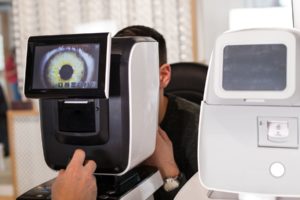It is estimated that more than 3 million Americans have glaucoma, but only half of those know they have it. Glaucoma is a leading cause of blindness. While everyone is at risk, some people are more likely to develop the eye disease than others. Staying mindful of these risk factors for glaucoma is key to recognizing its onset before it progresses.
Table of Contents
What Is Glaucoma?
Glaucoma develops when the optic nerve of the eye is damaged due to excess pressure created when fluid does not properly drain from the eye.
There are two types of glaucoma. In certain cases, angle-closure glaucoma occurs suddenly and has signs such as sudden blurry vision, severe eye pain, headache, and nausea that require immediate medical care. However, the more common form of glaucoma – primary open-angle glaucoma – occurs gradually, worsens over time, and has no signs at all.
Glaucoma Risk Factors to Keep in Mind
For that reason, it’s critical to monitor your eye health, especially if you have one or more of the following glaucoma risk factors. Without treatment, vision loss may occur.
Elevated Intraocular Pressure (IOP)
High eye pressure does not cause glaucoma, but it is a significant risk factor. Eye pressure is measured in millimeters of mercury (mm Hg). Normal eye pressure ranges from 12 to 22 mm Hg. Individuals who have numbers greater than that should have regular comprehensive eye exams to monitor this issue.
Age
Anyone of any age can get glaucoma, even infants. However, individuals over the age of 40 are at greater risk, and the risk increases as you continue to age.
Heredity
Having a history of glaucoma in the family is one of the greatest risk factors. Research suggests that more than 50 percent of glaucoma is based on heredity, and the rate of glaucoma can be 10 times higher among individuals with a sibling who has this eye disease. Individuals of African, Hispanic, or Asian heritage may be at greater risk as well.
Existing Vision Problems
Individuals who are farsighted or nearsighted may be at a higher risk for glaucoma.

Glaucoma risk factors include existing vision problems, elevated intraocular pressure, and heredity.
Other Health Concerns
Health issues that affect the whole body – such as diabetes, migraines, and high blood pressure – may affect the eyes as well.
Use of Certain Medications
Long-term use of certain medications, such as steroids, could be related to the onset of glaucoma.
Eye Composition
Additional glaucoma risk factors include having corneas that are thin in the center, as well as having thinning of the optic nerve.
Glaucoma Treatment & Monitoring
Fortunately, several highly effective options exist for glaucoma treatment.
In the early stages of glaucoma, managing the pressure in the eye with oral medications and eye drops may help stop the progression of the disease.
Surgical options include:
- Laser trabeculoplasty to drain fluid from the eye and relieve pressure
- Trabeculectomy to create channels for fluid to drain from the eye
If you know you are at risk for developing glaucoma due to heredity, past eye injury, or any of these other factors, getting regular comprehensive eye exams is the best way to recognize the onset.
Schedule an appointment online with one of our eye doctors or call us to book at a Michigan Eye Institute office near you!
Comments are closed.



